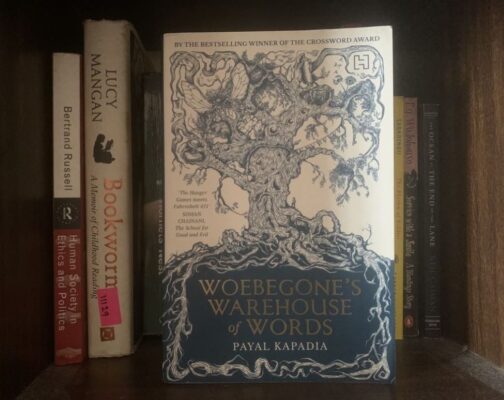Title: Woebegone’s Warehouse of Words
Author: Payal Kapadia
Cover design and Illustration: Damini Gupta (And it’s gorgeous!)
Type: Paperback
Age group: 12 years+ / 15 years+ depending on maturity (YA and adults)
Genre: Adventure / Dystopian / Speculative
Publisher: Hachette India
Length: 293 pages
I know. The name of the book doesn’t have wonderful in it. But it should have been there. For the words are wonderful. But more so the role the flesh-and-ink word Wonderful played in the story! It was cool. It was awesome. The two most popular words from the world Payal has created.
“Cool.”
“Awesome.”
Seems a little generic and inappropriate isn’t it?
Yes. It is. And that’s precisely the point. Perhaps a reflection of the times—Of our shallow conversations in syncopated time. Is it because our worldview is limited by the words we know?
Payal Kapadia’s Woebegone’s Warehouse of Words is a thrilling “what-if” tale, in a world where a speaker has to pay a price for every word they speak. A world where words and how they can use them comes with a detailed set of rules. A world where a common word like Cool and Awesome is easy to find and affordable, but words like Gossamer are quickly dying and more expensive. This young adult fiction masterfully blends elements of dystopia, adventure, and linguistic exploration to create a unique and engaging reading experience.
The story follows two friends, Asha and Zeb, who dare to break the stringent rules governing language use in their society. When Zeb suddenly disappears at the hands of the resident tyrant, Asha embarks on a thrilling adventure where the world of words and their speakers collide. What unfolds is a tale of oppression, dissent, resistance, and ultimately, reclamation.
Kapadia’s imaginative setting presents a “what-if” scenario where every word a person uses is subject to strict regulations and centralized control. This premise serves as a powerful allegory for contemporary issues surrounding free speech and information control.
The true beauty of this book lies in Kapadia’s masterful prose. Each word, phrase, and sentence is crafted with precision, inviting readers to pause, reflect, and contemplate. For instance, consider this description of a word’s erasure:
“Fading to nothing like the white heart of a blank page.”
Nothing to hold on to. Just whiteness. And the speaker left grasping at the void, as thoughts slip away, untethered and elusive. So, do speakers give power to the word, or do speakers get power from words?
Or consider this:
“The trail of the Lan-guage train were like needle-stitches through the arid fabric of the barrens.”
Can we keep an idea down even if the words disappear? Or do words make ideas? If words don’t exist would Art and Music suffice to create dissent? Kapadia explores this concept brilliantly through Zeb’s character. When Zeb uses paint to share his ideas, it evokes thoughts of real-world artists like Banksy, who creates art not as an elitist pursuit, but as a form of social commentary and dissent. This parallel underscores the power of visual art as a means of communication when words are restricted or controlled.
But would ideas get constricted too? What if the words we need are difficult to find – like a search result on the 5th page? Would that create a limited world view? Is that already happening with the echo-chambers we live in? Would that only get exacerbated with the AI engines telling us what to think?
Should we just be happy with the words we are fed — or could we take a moment and examine them? Are we the people we are expected to be, or could we rise from our roles and do our calling? Even the sad and the miserable can become the heart of resistance.
Like the author says, maybe it’s just the fear that keeps us in. In a world where words are increasingly curated and controlled, this book serves as a reminder of the importance of words, of expression and the power they bring.
Does this lyrical writing take away from the plot and the story?
‘Woebegone’s Warehouse of Words’ is more than just a story; it’s an invitation to examine the words we use and the ideas they represent. This book is recommended for both young adults and adult readers who enjoy thought-provoking fiction. It’s best read at a leisurely pace, allowing time to savour the words and ponder over the abstract ideas they present. As Kapadia advises in her author’s note, approach this book ready “To think fully, speak freely, imagine recklessly, experience fully.”
Other books by Payal Kapadia can be found here.
If you enjoyed this review and wish to get lost in the wonderful world of words, you should order the book from Amazon (kbc affiliate link),
CLICK & BUY NOW!Disclaimer: Mandira is part of the #kbcReviewerSquad and received this book as a review copy from the publisher via kbc. She is the author of the award winning book Children of the Hidden Land. Her new release Muniya’s Quest for middle graders is getting rave reviews!

![Woebegone’s Warehouse of Wonderful Words [Review]](https://www.kidsbookcafe.com/wp-content/uploads/2024/09/woebegones-warehouse-of-words.jpg)



